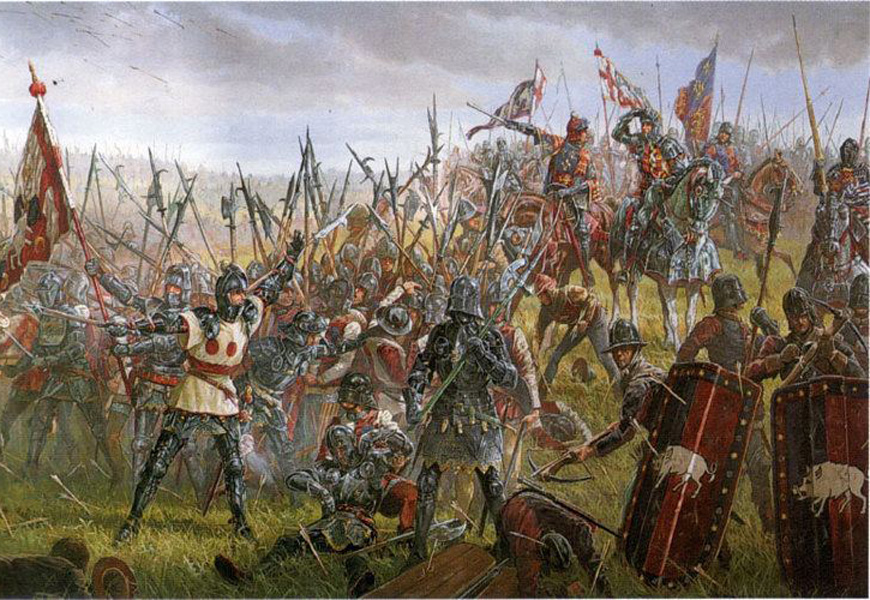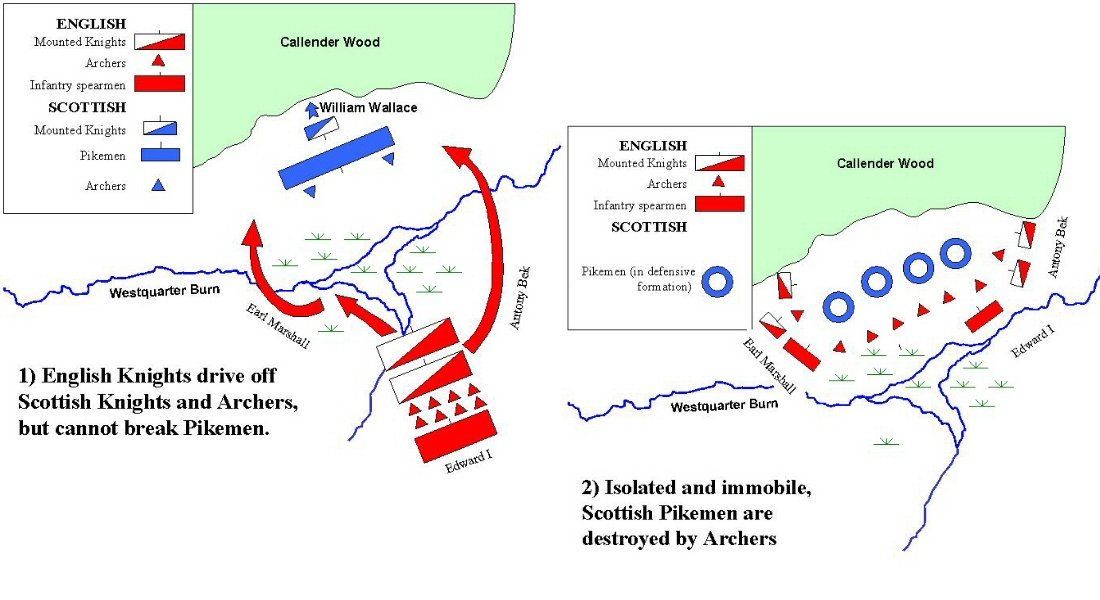Battle of Falkirk
Background
In September of 1297, Scottish forces under William Wallace and Andrew de Moray defeated the English at the Battle of Stirling Bridge. William Wallace was knighted and named Guardian of Scotland.
Wallace and his men then invaded northern England, raiding the countryside between Newcastle upon Tyne and Carlisle before returning to Scotland by early December with spoils to replenish their coffers. The Scottish army would settle in Selkirk Forest.
King Edward returned from France in March of 1298 and began organizing a new army to invade Scotland. He moved the government to York. A council of war was held in York in April to finalize details of the invasion. When no Scottish magnates attended, Edward declared them all to be traitors. The English army was ordered to assemble at Roxburgh on June 25th.
The English army moved from Roxburgh on July 3rd and reached Kirkliston, near Edinburgh, two weeks later, where they awaited supplies along the coastal ports, which were delayed by bad weather. Shipments of wine arrived first, and some Welsh bowmen in Edward's army indulged themselves on the wine, and their drunkenness evolved into a brawl, causing Edward to deal with the disturbance.
While at Kirkliston, Edward sent Antony Bek, the Bishop of Durham, to attack three nearby castles. Bek was initially beaten back at Dirleton Castle, but the castle fell on the second attempt. The other two castles were set on fire by the English after they were abandoned.

With Edward's army still strapped for supplies and nearly starving, he retreated to Edinburgh, hoping supplies would soon arrive before he had to decide to return to England.
The next morning, Edwards' scouts informed him that William Wallace and the Scots were only 18 miles to the west, waiting to pounce on the retreating English.
"When they heard that you planned to return to Edinburgh, they immediately decided to follow you and to attack your camp the following night," wrote Walter of Guisborough. To that, Edward said, "It will not be necessary for them to follow me, since I will go to meet them this very day."
Edward then moved the English army west, making camp at Linlithgow on July 21st. They would head to Falkirk arriving by dawn of July 22nd, 1298.
Battle
The English army comprised 12,900 infantry (5,500 longbowmen, 7,000 spearmen), and 2,250 knights on horse, which included 11 earls and 100 barons.
The Scottish army held the high ground and was made up of 9,500 infantry (1,500 archers, 8,000 spearmen), and 500 knights on horse.
The Scots were formed into four schiltrons of spearmen, supported by archers between the formations and the knights with Wallace behind the formations. Absent from the Scottish army were any forces from Robert the Bruce and the Comyns. Andrew de Moray was also not there, having been mortally wounded at the Battle of Stirling Bridge.
The English were divided into four battles that advanced two by two on both flanks. The vanguard, led by Henry de Lacy, Earl of Lincoln, advanced to the left, avoiding a marshy area. He was followed by the battle led by John de Warenne, 6th Earl of Surrey. Antony Bek led the first battle that moved to the right around the marshy area, followed by King Edward's battle.

De Lacy and Bek both charged the Scots, and de Lacy quickly routed the Scottish cavalry. The Scottish archers were commanded by Sir John Stewart, but were also run over by the English cavalry. The tightly packed Scottish schiltron formations held firm, able to repel any cavalry attacks with their spears. Edward's cavalry then fell back from the fighting as his infantry and longbowmen arrived.
The schiltrons were a formidable defense against heavy horse, but now found themselves trapped as the English longbowmen rained down arrow after arrow into their tight formations. Unable to retreat, the battle was all but over when the arrows began to decimate the schiltrons. Once weakened, the English infantrymen and cavalry launched an attack, causing the schiltron formations to break and the Scots to scatter. Some retreated to the safety of the woods and escaped, including William Wallace and parts of his inner circle.
Aftermath
Scotland lost several high-ranking leaders at Falkirk, including John de Graham, Wallace's second-in-command, as well as John Stewart and Macduff of Fife.
After the Battle of Falkirk, William Wallace retreated north and gutted Stirling as he fled, only leaving the House of the Blackfriars intact. He later resigned as Guardian of Scotland.
Edward would head north and occupy Stirling, taking the House of the Blackfriars as his headquarters. He would raid Ayrshire, Perth, and St. Andrews before moving south back into England at Carlisle by September.
Falkirk was a decisive victory for the English, showcasing the innovative tactic of using longbowmen to defeat schiltrons; however, Wallace was still alive, and the Scots' spirit was not broken. The War of Scottish Independence was still far from over.
Scribes created the Falkirk Roll after the battle, and it contains the arms of the English Barons and Noblemen present at the battle. It is the oldest known English roll of arms, containing 111 names and blazoned shields.







